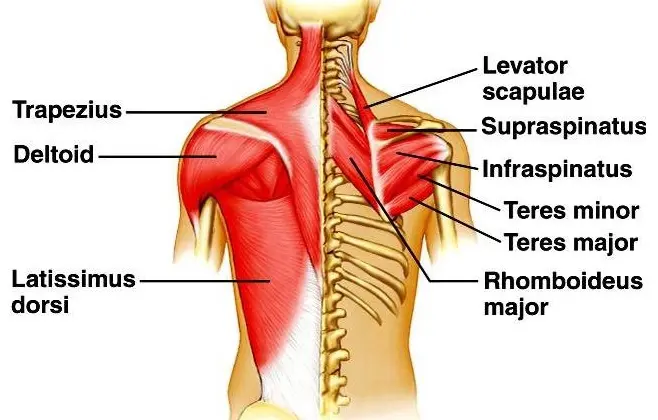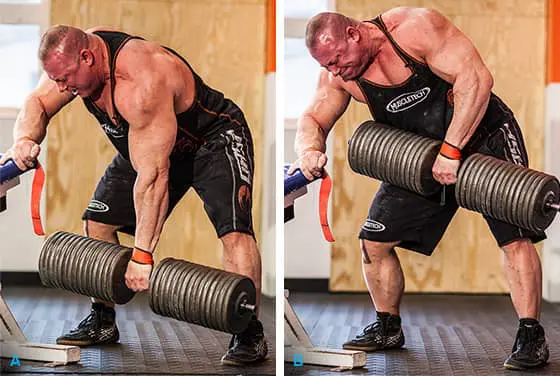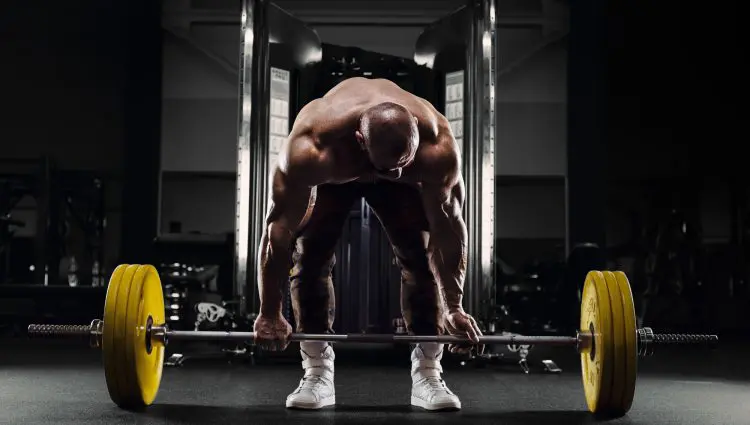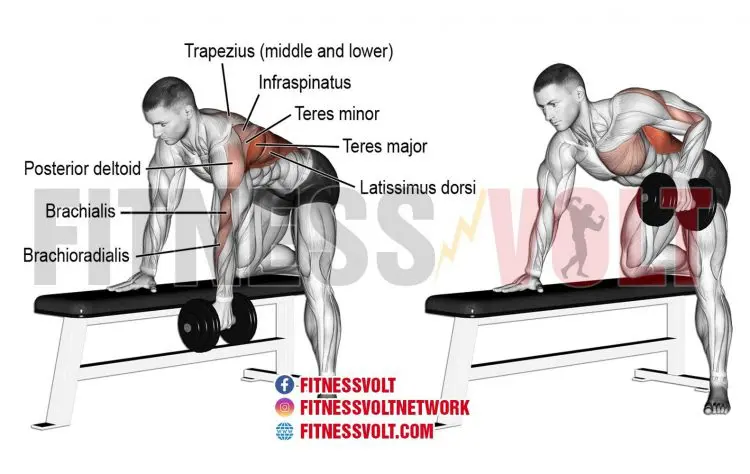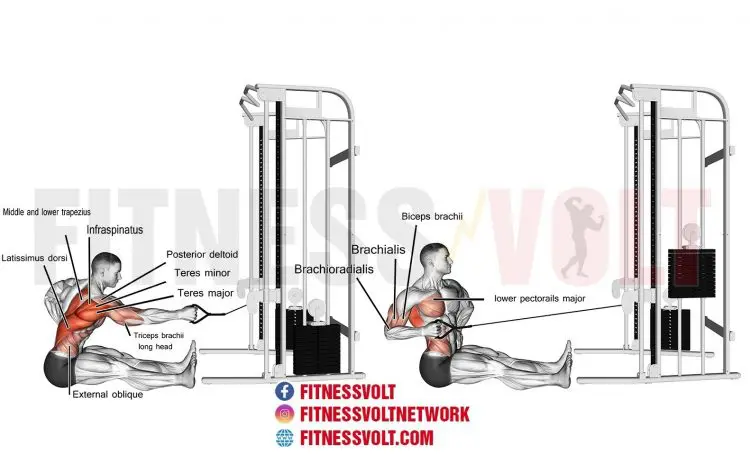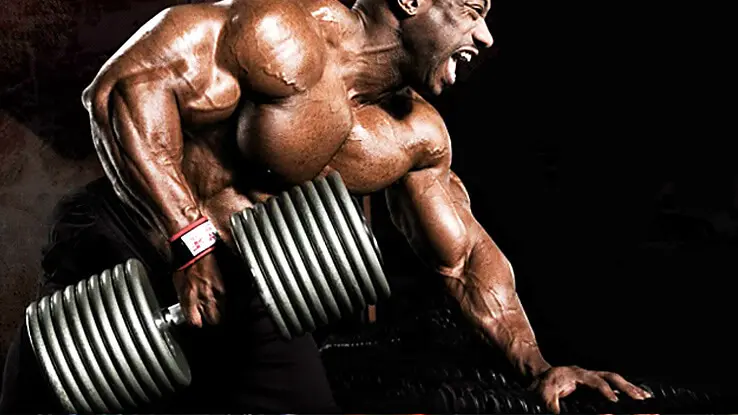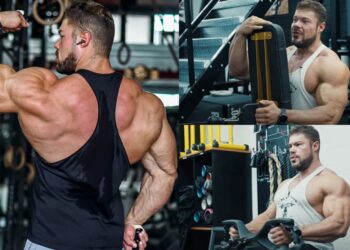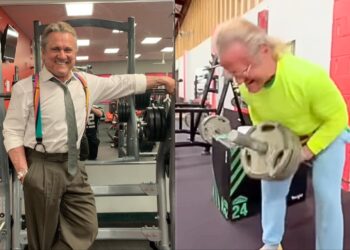There are two main ways to train your back – vertical pulling exercises such as pull-ups, chin-ups, and lat pulldowns, and horizontal pulling exercises, which are all variations of rows. Where vertical pulls give your back its width, rows tend to give your back its thickness. Subsequently, if you want to build the best possible back, you need both vertical AND horizontal pulls.
There are LOTS of rowing exercises to choose from, including T-bar rows, bent over barbell rows, and cable rows, and each one can be effective. However, when it comes to brutal back builders, the Kroc row is arguably the biggest and baddest of them all.
In this article, we lift the lid on this mythical exercise, reveal how to do it, and provide you with some useful alternatives too.
What are Kroc Rows?
Kroc rows are a variation of single-arm dumbbell rows. Named after bodybuilder and powerlifter Mathew Kroczaleski, who after gender reassignment is called Janae Marie Kroc, this exercise involves lifting heavy weights for high reps to build both muscle size and strength.
Kroc started doing their unique row when they realized that lack of grip and lat strength was having an adverse effect on their deadlift performance. Jim Wendler, powerlifter and inventor of the world-famous 5/3/1 training system, saw Kroc doing this rowing variation and named them Kroc rows, and started promoting them as a deadlift accessory exercise.
Unlike regular single-arm dumbbell rows, Kroc rows involve both the legs and the lower back so that you can do a whole lot of reps with massive weights. This is NOT a strict row. However, the combination of intensity and volume exposes the target muscles to a whole lot of mechanical and metabolic stress, which is what makes them so effective.
Level Up Your Fitness: Join our 💪 strong community in Fitness Volt Newsletter. Get daily inspiration, expert-backed workouts, nutrition tips, the latest in strength sports, and the support you need to reach your goals. Subscribe for free!
Check out the video below to see Kroc pumping out 25 reps with a massive 225lbs dumbbell.
Kroc Row Anatomy
Kroc rows are a compound exercise. That means they involve two or more joints and several muscles working together. Because Kroc rows involve some strategic cheating, they are virtually a full-body exercise. That said, the main muscles worked during Kroc rows are:
Latissimus dorsi – known as the lats for short, this is the largest muscle in your back. It’s located on the side of your torso, and its primary functions are adduction and extension of the shoulder joint. When well-developed, the lats give your back width and can look like wings.
Rhomboids and mid-traps – the rhomboids and mid traps are located between and across your scapulae or shoulder blades. They give your upper back its thickness and also play an important role in posture and shoulder stability.
Posterior deltoids – like most compound upper body exercises, Kroc rows involve all three deltoid muscles. However, as a shoulder extension exercise, the posterior or rear deltoids are especially active.
Biceps brachii – called the biceps for short, this is the muscle in the front of your upper arm. The biceps flex your elbow, supinate your forearm, and also flex your shoulder.
Forearms – several muscles make up your forearms, including brachioradialis, flexor carpi radialis, and palmer longus. While some forearm muscles help flex the elbow, others are responsible for your grip. Kroc rows target both types of forearm muscles.
Erector spinae – the collective name for the group of muscles that stabilize and extend your spine. Kroc rows involve a lot of back movement, which means they work the erector spinae more than regular single-arm rows.
How to do Kroc Rows
To the uninitiated, Kroc rows can look like regular single-arm rows done with sloppy technique. The reality is that, while the form IS looser than for regular rows, there is still a right way and a wrong way to do this exercise.
The right way minimizes your risk of injury while delivering the best possible results, while the wrong way is a fast track to elbow, shoulder, and back pain. Get the most from Kroc rows by doing them correctly.
- Hold a heavy dumbbell in one hand and stand with your feet about shoulder-width apart and one foot in front of the other.
- Lean forward and place your supporting hand on a stable bench, dumbbell rack, or similar. Your shoulders should be above your hips. Your upper body should be about 15-degrees to the floor.
- Alternatively, you can do Kroc rows with one knee resting on a bench, as you would with regular single-arm rows. However, you need to keep your hips lower than usual to get the ideal back angle.
- Brace your core to stabilize your spine and pull your shoulders down and back.
- Initiating the movement with your legs and hips, pull the dumbbell up and into the side of your abdomen. Shrug your shoulder back to maximally contract your upper back.
- Lower the weight, allowing your shoulder to flex forward at the bottom of each rep. Do not round your lower back.
- Explode up again and repeat, trying not to pause between reps.
- Kroc rows can be done with or without lifting straps.
Kroc Rows Advantages and Benefits
What makes this such a good exercise? Good question! The main benefits and advantages of Kroc rows are:
1. Heavy weights AND high reps
Usually, you can train heavy and do low rep sets, or lift lighter weights and do more reps. Kroc rows allow you to use heavy weights and do high reps, creating a unique strength and muscle-building stimulus. The extra leg drive and body movement mean you can keep pumping out the reps when you would have failed much sooner if you were doing a stricter movement.
2. Extra back support
When you do Kroc rows, your non-working arm helps support your spine, which may take stress off your lower back. Kroc rows involve less low back strain than unsupported rowing exercises such as T-bar rows, Pendlay rows, and bent over barbell rows, but more than strict single-arm rows.
3. Time efficiency
After 1-3 warm-up sets, Kroc rows are usually done for just one set per arm. If you can do more than one set, you probably didn’t go hard or heavy enough. This makes Kroc rows a very time-efficient exercise and ideal for when you want a big, bad, back workout but don’t have a lot of time to train.
4. Boost your deadlift performance
Kroc rows can boost your deadlift performance in several ways. After all, Kroc started doing this rowing variation specifically for this purpose. Adding this exercise to your workout plan will:
- Increase upper and lower back strength
- Strengthen your grip
- Increase hip drive
- Improve shoulder and upper back stability
- Increase core strength
5. Mental toughness
On paper, Kroc rows look relatively straightforward. They’re just single-arm dumbbell rows done with a little body English, right?! The reality is that this exercise is brutal and will tax almost your entire body, as well as your cardiovascular system. If you don’t feel exhausted after a set of all-out Kroc rows, you didn’t do them right. Such an intense exercise won’t just affect you physically; it’ll toughen you up mentally too.
Kroc Row Programming
According to the inventor, Kroc rows should be done for sets of 20+ reps using the heaviest weight you can manage, and you should keep going until you reach failure.
While you can wear straps to enhance your grip, Kroc says that, if you do, they should only be used every other week. If you always do Kroc rows with straps, you’ll miss out on the grip-building effect of this exercise.
You can use Kroc rows as an assistance exercise after deadlifts or, if you prefer, as your main back builder followed by 2-4 additional lat exercises. Because it’s such an effective move, you could also use it as your main back exercise if you don’t have time for a longer workout or practice HIT – High-Intensity Training – where you do just one set to failure of each exercise.
Kroc Row Alternatives
As amazing as Kroc rows undoubtedly are, they aren’t the only rowing exercise you can use to build a bigger, more muscular back. If you do it too often or for too long, it will eventually lose its potency. Keep your back workouts fresh and productive with these other single-arm rowing exercises.
1. Single-Arm Dumbbell Bent Over Rows
Kroc rows are a variation of this classic dumbbell exercise. Before progressing to Kroc rows, make sure you have mastered the original version. With regular single-arm dumbbell rows, your torso is more-or-less parallel to the floor, and there is minimal additional movement. It’s a much stricter exercise, but that means you won’t be able to lift as much weight or do as many reps before hitting failure.
Level Up Your Fitness: Join our 💪 strong community in Fitness Volt Newsletter. Get daily inspiration, expert-backed workouts, nutrition tips, the latest in strength sports, and the support you need to reach your goals. Subscribe for free!
Learn how to do single-arm dumbbell rows here.
2. Seated Twisting Cable Row
This exercise is a sort of seated version of Kroc rows. Like Kroc rows, it involves a large range of motion. That said, seated twisting cable rows involve no real help from your legs, so you won’t be able to go as heavy. Despite this, seated twisting cable rows are an effective single-arm row and a decent alternative for Kroc rows.
Check out this article and learn how to do this effective back exercise.
3. Single-Arm Dead-Stop Row
This is a dumbbell version of the famous back builder, the Pendlay row. It’s basically a single-arm dumbbell row but, with this version, each rep starts and ends with the dumbbell resting on the floor.
Pausing on the floor between reps eliminates momentum, and starting each rep from stationary means you need to accelerate the weight up, increasing muscle power.
The brief pause between reps also provides a chance to relax and reset your grip and takes stress off your lower back.
4. Single-Arm Machine Row
If you have access to a chest supported rowing machine, there is nothing to stop you from doing that exercise with one arm at a time. Using just one arm means you can really stretch forward at the end of each rep, mirroring one of the aspects of Kroc rows.
If you want to do Kroc rows but are worried about your lower back, this could be the alternative you’ve been looking for.
5. Single-Arm Smith Machine Row
While most people are familiar with Smith machine squats, bench presses, and overhead presses, single-arm Smith machine rows are much less known. That’s a shame because, as unilateral lat exercises go, this one is very effective.
How to do it:
- Set the bar on a Smith machine to about mid-shin height. Stand sideways on to the bar.
- Bend your knees slightly and hinge forward at the hips. Reach down and grab the bar in the center. Brace your abs, place your opposite hand on your leg for support, and arch your lower back slightly.
- Bend your arm and row the bar up. Keep your wrist straight, pull your shoulder back, and focus on leading with your elbow.
- Lower the bar and repeat.
6. Meadows Row
The Meadows row is a single-arm rowing exercise named after bodybuilder John “The Mountain Dog” Meadows. Like Kroc rows, it’s quite unique and will challenge your muscles in a new and unusual way. The Meadows row is a useful exercise for adding some variety to your back-building workouts.
How to do it:
- Stand at the end of a T-bar row machine, so you are perpendicular to the bar. Alternatively, you can use a landmine device or a barbell with one end wedged into a corner.
- Reach down and grab the end of the bar with your nearest hand. Keep your knees slightly bent.
- Without rounding your lower back, row the end of the bar up and into the side of your ribs.
- Extend your arm and repeat.
- You can create a Meadows/Pendlay row hybrid by resting the weight on the floor between reps.
7. Single-Arm Rows with Bands
This exercise turns regular single-arm rows into a MUCH more challenging exercise. Adding a band forces you to pay more attention to shoulder extension, which increases lat activation. You don’t need a strong band OR heavy weights for this exercise, making it ideal for home and garage-based workouts, as well as prehab and rehab.
To do this exercise, set up for single-arm dumbbell (or kettlebell) rows as usual, but then place your wrist inside a loop-type resistance band attached to a nearby anchor point. Row as normal but pay extra attention to pulling the weight back toward your hip.
Important Kroc Row Performance Tips
Get the most from this exercise by implementing the following Kroc row tips!
1. Take Care not to Round Your Lower Back
A rounded lower back is a weak lower back. Rounding your lumbar spine puts a lot of stress on your intervertebral disks and spinous ligaments. Both of these structures are easily injured and heal slowly due to their poor blood supply.
Avoid unnecessary injuries during Kroc rows by bracing your abs and keeping your lower back slightly arched. Wearing a weightlifting belt may also be useful.
2. Use Chalk
Your grip is a critical part of Kroc rows. That’s why a lot of lifters use straps for this exercise. Whether you use straps or not is up to you, but using chalk will ensure your hands are dry and that your dumbbell won’t slip out of your fingers.
Kroc rows are hard enough without having to worry about sweaty hands. Use chalk before each set so you can put all your energy into cranking out as many reps as possible.
3. Experiment With Your Position
A lot of people do Kroc rows with one knee on a bench. Others do them both feet on the floor and using a parallel stance. Some use a split stance. The good news is that all of these options are correct. Try them all and see which one feels the most comfortable, allows you to use the most weight, and pump out the most reps.
4. Use a Full Range of Motion
Get a better back workout from Kroc rows by using a full range of motion. Extend your shoulder as you lower the weight, and then retract it as you pull the weight back up. Kroc rows involve a lot more than just your arms. Make sure you also put your shoulders and upper back into the movement for the best results.
5. Rest Between Sets
Most strength and conditioning experts agree that one set of Kroc rows per side is all you need and all you should be able to do! Because Kroc rows involve so many muscle groups, you should always take a minute or two between arms. If you don’t, you may find that your core and lower back are still tired and affect your performance.
Kroc rows should be done to failure, and that takes a lot out of your body. Taking a longer rest will ensure you can work both sides of your body equally. Ideally, you should do the same number of reps on both sides.
6. Go Heavy (or Go Home!)
If you can strictly one-arm row the weight you are about to use for the Kroc row, it’s too damn light! One of the most critical features of Kroc rows is that they are done using heavy weights. While we can’t tell you how much weight you should lift for Kroc rows, whatever dumbbell you are thinking of using, you should probably use a heavier one.
The momentum and the fact you are going to do just one set means you can lift more weight than you realize. That doesn’t mean you should jump in with the heaviest dumbbell at your gym. However, if you aren’t using a weight that makes you feel a little nervous, you probably aren’t aiming high enough.
Wrapping Up
There are lots of exercises named after the person who invented or popularized them. Arnold presses, Zottman curls, Pendlay rows, Zercher squats, Hack squats, and Yates rows, to name a few. Each one is uniquely beneficial and put a twist on a more commonly known exercise.
Kroc rows are another variation of a well-known exercise, and they are one of the best back strength and size exercises around. However, they are also a little risky because they involve some heavy weights, high reps, and some purposeful cheating. If you add Kroc rows to your workouts, introduce them gradually, and increase your weights over several weeks. You SHOULD go heavy, but make sure you don’t go too heavy too soon.
However, if you want an exercise that will build your back, your biceps, and your grip in double quick time, and you like big, brutal workouts, Kroc rows are definitely worth doing.
Interested in measuring your progress? Check out our strength standards for Bench Press, Zercher Squat, Arnold Press, and more.

